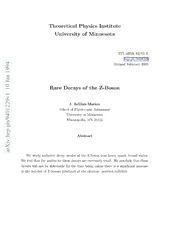
Rare Decays of Z-boson PDF
Preview Rare Decays of Z-boson
Theoretical Physics Institute University of Minnesota TPI-MINN-92/57-T hep-ph/9401229 4 Revised February 1993 9 9 1 n a J 0 Rare Decays of the Z-Boson 1 1 v 9 2 J. Jalilian-Marian 2 1 School of Physics and Astronomy 0 4 University of Minnesota 9 / Minneapolis, MN 55455 h p - p e h Abstract : v i X r a We study radiative decay modes of the Z-boson into heavy quark bound states. We find that the widths for these decays are extremely small. We conclude that these decays will not be detectable for the time being unless there is a significant increase in the number of Z-bosons produced at the electron- positron colliders. Rare decays of the Z-boson have recently been studied at the e+e− colliders, CERN’s LEP and the SLAC Linear Collider, where branching ratios down to 10−6 corresponding to a few Kev can be measured [1]. The partial decay widths of the Z- boson to a photon and bound states of heavy quarks (J/ψ) have been previously cal- culated by using Bethe-Salpeter wavefunctions for the quarkonium state and model- dependent potentials and found to be about .2 Kev [2] which might be observebale soon. However, using a model-independent method, we show that these decay widths are actually much smaller than previously reported. Calculation of the amplitudes A(Z→ J/ψγ) and A(Z→ Υγ) We are considering the decays Z→ J/ψγ and Z→ Υγ. The quark diagrams for the first decay are shown below with similar diagrams for the second case (replace c ¯ and c¯by b and b). Fig.1. The quark diagrams for Z→ J/ψγ decay Here we are assuming that the quarks inside the meson are at rest with respect to each other. In other words, we are making the approximation that P(c) = 1P(J/ψ)+ 2 O( µ ),where µ = .5 Gev is the characteristic hadronic scale here. This is not a very mc good approximation for the c quark, but is much better for the b quark [3]. Then we will have m2 = 4m2 , (P +K)2 = M2/2 and Q = 2P +K where m and P are the J/ψ quark mass and momentum, M and Q are the Z-boson mass and momentum and K 1 is the photon momentum. The amplitude is given by: −ig A(Z → J/ψγ) = ǫzǫ hJ/ψ|C¯{[( )γµ(C −C γ5) (1) µ ν 2cosθ v A w i i ( )(iQ eγν)]+[(iQ eγν)( ) c c (6 P− 6 Q)−m (6 Q− 6 P)−m −ig ( )γµ(C −C γ5)]}C|0i v A 2cosθ w Here, ǫz and ǫ are polarization vectors of the Z-boson and photon respectively µ ν and e2 = 4πα where α = 1/137 is the electromagnetic coupling constant and g = e , Q = 2/3 is the charmed quark electric charge, C = T3 − 2sin2θ Q and sinθw c v w c C = T3 are respectively the vector and axial vector coupling in the Weinberg-Salam A theory,T3 is equal to 1 for a c quark and −1 for a b quark, sin2θ ≃ .23 and 2 2 w σµν = i/2(γµγν −γνγµ). Eq.(1) can be simplified, after some γ matrix algebra and using the identity γµγλγν = gµλγν+gλνγµ−gµνγλ+iǫσµλνγ γ5 andtheDiracequationU¯(P)(6 P−m) = 0 σ and (6 P +m)V(P) = 0 to, 2iQ eg A(Z → J/ψγ) ≃ c ǫzǫ hJ/ψ|C¯{[−2iC (Q −P )ǫσµλνγ γ5]− (2) 3M2cosθ µ ν v λ λ σ [C (4miσνµγ5 −2Pµγνγ5 +2Pνγµγ5 + A 2iǫσµλνQ γ )]}C|0i λ σ The term involving σνµγ5 is proportional to ǫνµλσσ and in general, has non-zero λσ matrix element in the above expression, but its’ contribution is of the order of m2 M2 and here, we have neglected m2 terms. Now, using the fact that the matrix element M2 of a pseudo-vector taken between a vector state and vacuum state is zero, we get, −4Q egC A(Z → J/ψγ) ≃ c Aǫzǫ ǫσµλνQ hJ/ψ|C¯γ C|0i (3) 3M2cosθ µ ν λ σ The matrix element of the vector current in the above equation can be written as, hJ/ψ|C¯γ C|0i = 4g m2φ (4) σ v σ where φ is the polarization vector of J/ψ and g is experimentally found to be about σ v .13. Now, squaring the amplitude will give us, 2 224π2α2Q2C2g2m4 |A¯(Z → J/ψγ)|2 ≃ c v v cos2θ sin2θ M2 w w Forthe(Z→ Υγ)decay, wefollowthesameprocedurewithhΥ|¯bγµb|0i = 4g′ m2φµ v b and g′ is found from Υ → e+e− decay rates to be about .04 . Then, v 224π2α2Q2C2g′2m4 |A¯(Z → Υγ)|2 ≃ b v v b cos2θ sin2θ M2 w w and for the decay rates, using M = 91Gev,m ≃ 1.5Gev,m ≃ 4.5Gev and massless c b two-body decay phase space, we get Γ(Z → J/ψγ) ∼ 10−10Gev and Γ(Z → Υγ) ∼ 10−9Gev To summarize, we have shown that decay widths for Z→ J/ψγ and Z→ Υγ are much smaller than previously reported and unfortunately, will not be experimentally observable for the time being. I would like to thank Professor M.A. Shifman for bringing this problem to my attention and many helpful discussions. I would also like to thank the referee of Zeitschrift fu¨r Physik C for pointing out a most crucial error in the earlier version of this paper. References [1] W. Bearnreuther, M.J. Duncan, E.W.N. Glover, R. Kleiss, J.J. Van der Bij, J.J. Gomez-Cadenas and C.A. Heusch, CERN Report No. TH.5484/89 (unpub- lished); T.J. Weiler, in Proceedings of the Second International Symposium on theFourthFamilyofQuarksandLeptons, SantaMonica, California,1989,edited by D.B. Cline and A. Soni (New York Academy of Sciences, New York). [2] G. Guberina, J.H. Ku¨hn, R.D. Peccei, and R. Ru¨ckl, Nucl. Phys. B174, 317(1980); J.H. Ku¨hn, Acta. Phys. Pol. B12, 347(1981). [3] M.A. Shifman and M.I. Vysotsky, Nucl. Phys. B186, 475(1981). 3 This figure "fig1-1.png" is available in "png"(cid:10) format from: http://arXiv.org/ps/hep-ph/9401229v1
